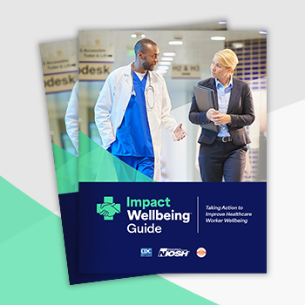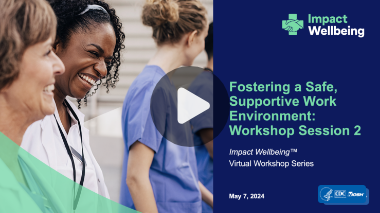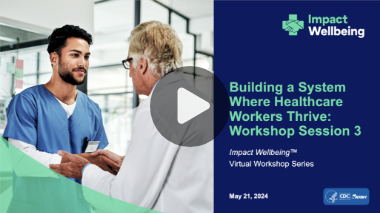Impact Wellbeing™ Guide Workshop Series Brings Together Hospital Leaders to Improve Healthcare Worker Wellbeing
Posted on by
NIOSH’s Impact Wellbeing™ campaign gives hospital leaders evidence-informed solutions to reduce healthcare worker burnout and sustain wellbeing. The goal is to build a system where healthcare workers thrive. It helps hospital leaders go beyond individual resilience efforts and encouraging self-care to instead focus on systems-level improvements.
 Many hospitals face challenges getting started or have concerns about the resources needed for wellbeing work. NIOSH developed the Impact Wellbeing Guide: Taking Action to Improve Healthcare Worker Wellbeing with the Dr. Lorna Breen Heroes’ Foundation. It can support workplace improvements in any hospital system. The Guide was real-world tested in six hospitals across the United States in the CommonSpirit health system. Guide authors used the feedback to refine the content and develop a wider range of helpful tools and resources. NIOSH publicly launched the Guide on March 18, 2024, in recognition of the first Health Workforce Well-being Day.
Many hospitals face challenges getting started or have concerns about the resources needed for wellbeing work. NIOSH developed the Impact Wellbeing Guide: Taking Action to Improve Healthcare Worker Wellbeing with the Dr. Lorna Breen Heroes’ Foundation. It can support workplace improvements in any hospital system. The Guide was real-world tested in six hospitals across the United States in the CommonSpirit health system. Guide authors used the feedback to refine the content and develop a wider range of helpful tools and resources. NIOSH publicly launched the Guide on March 18, 2024, in recognition of the first Health Workforce Well-being Day.
To build upon the launch of the Guide, NIOSH hosted a three-part virtual workshop series. The series further explored the Guide’s Actions, goals, and associated resources. Participants explored ways to make systems-level changes within their hospitals and build trust between leaders and healthcare workers. They also got to hear examples of the Actions in practice from wellbeing experts and hospital leader peers. Each session covered two of the six Actions in the Guide, which will enable participants to:
- Conduct a review of hospital operations to determine how they support professional wellbeing.
- Build a dedicated team to support professional wellbeing.
- Break down barriers to seeking help, such as removing intrusive mental health questions on credentialing applications.
- Develop a suite of communication tools to share updates with the workforce about professional wellbeing efforts.
- Integrate professional wellbeing into an existing quality improvement project.
- Create a 12-month plan to continue to move professional wellbeing work forward.
 The first workshop, Getting Started to Impact Wellbeing, focused on Actions 1 and 2. The session opened with a discussion about the importance of the role of leadership in reducing healthcare worker burnout. NIOSH Director Dr. John Howard emphasized the importance of making organizational changes rather than relying solely on building individual resilience. Dr. Paul Rains, Systems Senior Vice President of Behavioral Health at CommonSpirit also spoke. He shared the critical nature of keeping this topic at the forefront of hospital initiatives despite competing priorities. The session then provided an overview of Action 1: Review Your Hospital’s Operations. Two hospital leaders shared how they took stock of their hospital’s current operations and built upon existing efforts. A speaker from the University of Utah Health shared how they used their existing customer experience efforts as a bridge to focus on staff wellbeing. The session continued with an overview of Action 2: Build Your Professional Wellbeing Team. In the final section, two speakers from Inova Health system shared how they built their Professional Wellbeing Team. Inova executive leadership considered multiple potential team structures, ultimately choosing to build upon their existing matrix approach. This structure included leadership from their Chief People Officer and support from their Director of Behavioral Health. Mid-level managers model wellbeing for front-line staff.
The first workshop, Getting Started to Impact Wellbeing, focused on Actions 1 and 2. The session opened with a discussion about the importance of the role of leadership in reducing healthcare worker burnout. NIOSH Director Dr. John Howard emphasized the importance of making organizational changes rather than relying solely on building individual resilience. Dr. Paul Rains, Systems Senior Vice President of Behavioral Health at CommonSpirit also spoke. He shared the critical nature of keeping this topic at the forefront of hospital initiatives despite competing priorities. The session then provided an overview of Action 1: Review Your Hospital’s Operations. Two hospital leaders shared how they took stock of their hospital’s current operations and built upon existing efforts. A speaker from the University of Utah Health shared how they used their existing customer experience efforts as a bridge to focus on staff wellbeing. The session continued with an overview of Action 2: Build Your Professional Wellbeing Team. In the final section, two speakers from Inova Health system shared how they built their Professional Wellbeing Team. Inova executive leadership considered multiple potential team structures, ultimately choosing to build upon their existing matrix approach. This structure included leadership from their Chief People Officer and support from their Director of Behavioral Health. Mid-level managers model wellbeing for front-line staff.
 The second workshop, Fostering a Safe, Supportive Work Environment, focused on Actions 3 and 4. Corey Feist from the Dr. Lorna Breen Heroes’ Foundation and Daniel Blaney-Koen at the American Medical Association started the session. They described the importance of removing intrusive mental health questions from credentialing applications. Physicians and other credentialed providers may fear losing their hospital credentials because of these invasive questions. They may choose not to seek mental health care [1,2]. Next, two hospital leaders provided an example of Action 3: Break Down Barriers for Help-Seeking, in practice. They shared a case study of how hospitals across Virginia successfully updated their credentialing applications. The session continued with a presentation about Action 4: Communicate Your Commitment to Professional Wellbeing. After this, two leaders from Wellstar Douglas Medical Center in Georgia shared how their hospital employs two-way communication with staff. They discussed the value of sharing wellbeing resources with staff. It’s also important that your wellbeing team has a dedicated liaison between workers and leadership.
The second workshop, Fostering a Safe, Supportive Work Environment, focused on Actions 3 and 4. Corey Feist from the Dr. Lorna Breen Heroes’ Foundation and Daniel Blaney-Koen at the American Medical Association started the session. They described the importance of removing intrusive mental health questions from credentialing applications. Physicians and other credentialed providers may fear losing their hospital credentials because of these invasive questions. They may choose not to seek mental health care [1,2]. Next, two hospital leaders provided an example of Action 3: Break Down Barriers for Help-Seeking, in practice. They shared a case study of how hospitals across Virginia successfully updated their credentialing applications. The session continued with a presentation about Action 4: Communicate Your Commitment to Professional Wellbeing. After this, two leaders from Wellstar Douglas Medical Center in Georgia shared how their hospital employs two-way communication with staff. They discussed the value of sharing wellbeing resources with staff. It’s also important that your wellbeing team has a dedicated liaison between workers and leadership.
 The third and final workshop, Building a System Where Healthcare Workers Thrive, focused on Action 5: and 6. The session started with an overview of Action 5: Integrate Professional Wellbeing into Quality Improvement. Two hospital leaders shared how they use the quadruple and quintuple aim frameworks [3, 4] to simultaneously improve professional wellbeing and health equity. For example, Michigan Medicine implemented a predictive model for clinician decision-making to improve their scheduling process. As a result, physician associates reported better work-life balance, and patients also liked the change. Johns Hopkins School of Medicine shared an innovative approach to reducing the administrative burden of prior authorization [5]. The session next reviewed Action 6: Develop Your Long-Term Professional Wellbeing Plan. Other leaders discussed how they developed long-term professional wellbeing plans with longer-term goals and shorter-term process measures. Leaders reinforced that it is important for these plans to fit the culture of the organization and have input from all levels. These include executive leaders, middle managers, and frontline staff. The workshop closed with a keynote from returning speakers Dr. John Howard and Dr. Paul Rains. They emphasized how leaders’ genuine care for their workforce, backed up by action, positions them to continue making strides long-term.
The third and final workshop, Building a System Where Healthcare Workers Thrive, focused on Action 5: and 6. The session started with an overview of Action 5: Integrate Professional Wellbeing into Quality Improvement. Two hospital leaders shared how they use the quadruple and quintuple aim frameworks [3, 4] to simultaneously improve professional wellbeing and health equity. For example, Michigan Medicine implemented a predictive model for clinician decision-making to improve their scheduling process. As a result, physician associates reported better work-life balance, and patients also liked the change. Johns Hopkins School of Medicine shared an innovative approach to reducing the administrative burden of prior authorization [5]. The session next reviewed Action 6: Develop Your Long-Term Professional Wellbeing Plan. Other leaders discussed how they developed long-term professional wellbeing plans with longer-term goals and shorter-term process measures. Leaders reinforced that it is important for these plans to fit the culture of the organization and have input from all levels. These include executive leaders, middle managers, and frontline staff. The workshop closed with a keynote from returning speakers Dr. John Howard and Dr. Paul Rains. They emphasized how leaders’ genuine care for their workforce, backed up by action, positions them to continue making strides long-term.
The workshop recordings are available as a YouTube playlist and on the Impact Wellbeing Guide webpage. We invite you to share examples of how you’ve used the Impact Wellbeing Guide or made operational changes to improve healthcare worker wellbeing in the comments.
Emily Novicki, MA, MPH, is a Health Scientist in the NIOSH Office of the Director.
Stefanie Simmons, MD, FACEP, is the Chief Wellbeing Officer of the Dr. Lorna Breen Heroes’ Foundation.
Claire Viscione, BS, is a Senior Account Executive at JPA Health.
Mention of any company or product does not constitute endorsement by the National Institute for Occupational Safety and Health, Centers for Disease Control and Prevention.
References
- American Nurses Foundation [2021]. Pulse of the nation’s nurses survey series: Mental health and wellness: Taking the pulse on emotional health, post-traumatic stress, resiliency, and activities for strengthening wellbeing. Silver Spring, MD: American Nurses Foundation.
- The Physicians Foundation [2022]. 2022 survey of America’s physicians: Part two of three: Understanding the state of physicians’ wellbeing and assessing solutions to address it. Boston, MA: The Physicians Foundation
- Bodenheimer T, Sinsky C. From triple to quadruple aim: care of the patient requires care of the provider. The Annals of Family Medicine. 2014 Nov 1;12(6):573-6.
- Nundy S, Cooper L, Mate K [2022]. The quintuple aim for health care improvement: A new imperative to advance health equity. JAMA 327(6):521-522.
- Pestaina K and Pollitz K [2022]. Examining Prior Authorization in Health Insurance. San Francisco, CA: Kaiser Family Foundation. https://www.kff.org/policy-watch/examining-prior-authorization-in-health-insurance/
Posted on by

